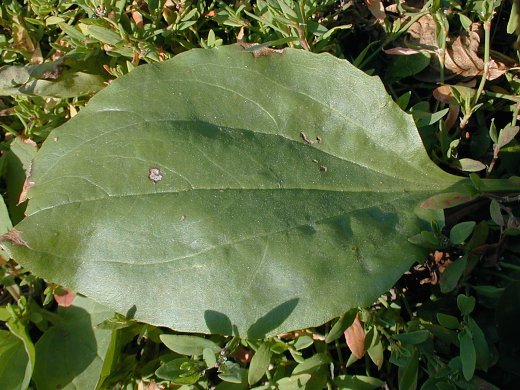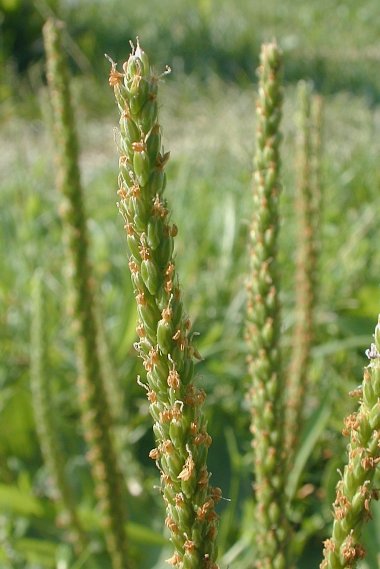Description: This is a herbaceous perennial plant that consists of a low-growing rosette of basal leaves, from which flowering stalks up to 10" tall emerge from the center. The basal leaves are up to 6" long and 4" across, and have long petioles. They are oval, parallel-veined, hairless, and have smooth margins that occasionally undulate. The petioles near the base of the rosette are light purple on some plants. The flowering stalks are unbranched and narrowly cylindrical. Each scape consists of a rather dense spike of tiny green flowers and their bracts. Each flower is less than 1/8" (3 mm.) long and consists of 4 sepals, which are surrounded by lanceolate bracts.

The blooming
period usually occurs during the summer, and sometimes later if there
is a major disturbance that prevents development of the flowering
stalks. Pollination is by wind, rather than insects. The flowers
rapidly turn brown, and are replaced by elongated seed capsules that
are shaped like a tiny narrow acorn. They split open to below the
middle by a lid, releasing 2-9 seeds each. The seeds are black, oval
and slightly angular, with a tiny indentation in the middle of one
side. There is no reticulation on the surface. These seeds become
sticky when wet, and can attach themselves to blowing leaves and other
passing objects. The root system is quite branched and coarsely fibrous.
Cultivation:
The preference is full or partial sun, and moist to mesic conditions in
fertile, loamy soil. Soil with a high clay or gravel content is readily
tolerated, but will stunt the growth of the plants. The leaves will
wilt during a drought, but this is rarely lethal. Black-Seeded Plantain
readily reseeds itself, and can spread to locations where it is
undesired. The seeds can remain viable in the ground for several years,
if not decades.

Range
& Habitat:
This common native plant occurs throughout Illinois (see Distribution
Map). It can be found occasionally in open disturbed areas of
prairies, sometimes as an invader from more developed sites, such as
lawns. Other natural habitats include disturbed areas of meadows in
woodlands, woodland borders, and clay banks along streams. In more
developed areas, where this plant is ubiquitous, it can be found in
lawns, gardens, and vacant lots, or areas along roadsides, railroads,
sidewalks, gravelly driveways and alleys. Black-seeded Plantain thrives
on
disturbance, and it cannot tolerate much competition from taller plants
with highly developed root systems.
Faunal Associations:
Various insects feed on the foliage, roots, and other parts of
plantains (Plantago spp.), such as Dibolia
borealis (Northern Plantain Flea Beetle), Dysaphis plantaginea (Rosy
Apple Aphid), larvae of Phytomyza
plantaginis and other leaf-miner flies, larvae of a
butterfly, Junonia
coenia (Buckeye), larvae of Virbia aurantiaca (Orange
Virbia) and other moths, Melanoplus
femurrubrum (Red-legged Grasshopper) and other
grasshoppers, and Neoconocephalus
ensiger (Sword-bearing
Conehead); see the Insect Table for a more complete list of these
insects. Among vertebrate animals, rabbits,
groundhogs, and deer eat the leaves and flowering stalks. Squirrels eat
the seed capsules occasionally, including the Fox Squirrel, Gray
Squirrel, and the uncommon Franklin's Ground Squirrel. Among birds, the
Northern Cardinal and Grasshopper Sparrow eat the seeds, while the
Greater Prairie Chicken eats both seeds and leaves (Martin et al.,
1951/1961; Schwartz, 1945). Because the seeds of plantains can become
mucilaginous and sticky while wet, they can cling to the feet and fur
of mammals. The seeds of these plants can also pass through the
digestive
tracts of deer and other animals and remain sufficiently viable to
germinate (Myers et al., 2004). By these means, the seeds are spread to
new locations.

Photographic
Location:
The photographs were taken along a gravel driveway in Urbana, Illinois.
Comments:
This plant closely resembles Common Plantain (Plantago major)
from Eurasia. Black-Seeded Plantain (Plantago rugelii)
differs from the latter
species by the appearance of its seeds (e.g., they are black and lack
surface reticulation) and its more narrow seed capsules. This plant is
widely regarded as an unattractive weed, but its ecological value,
particularly to mammals and moths, is rather high.